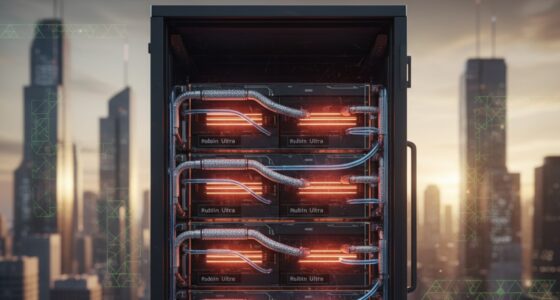Executive summary (2 pages)
Europe has entered an execution phase on AI-sovereign infrastructure. Two signals stand out:
- EuroHPC’s expanding network of “AI Factories.” On 10 Oct 2025 the EuroHPC Joint Undertaking selected six additional AI Factories (Czechia, Lithuania, Netherlands, Poland, Romania, Spain), bringing the network to 19 Factories across 16 Member States and adding a complementary layer of AI Factory “Antennas” to widen access. These sites provide AI-optimized supercomputing, data, and services for startups/SMEs and researchers—Europe’s “one-stop” on-ramp to compute. NL+3EuroHPC+3Digital Strategy+3
- A dramatic capacity surge around Milan. Within days of each other, Vantage announced a second Milan campus (MXP2, ~€350M, 32 MW IT) while Echelon unveiled LIN10 (up to 250 MVA gross power; 100 MVA immediately available; €3B total). Days later, A2A’s CEO projected the Milan area could scale from ~200 MW today to roughly 2 GW in five years—10× growth driven by AI workloads. Reuters+6Vantage Data Centers+6Data Center Dynamics+6
Why it matters:
- The EU is building public-interest compute and market-scale capacity in parallel—de-risking access for innovators while crowding-in private capital.
- Italy (Milan) is emerging as a new Tier-1 AI hub—shifting Europe’s gravity beyond the FLAP/D markets and testing new grid, permitting, and siting models at speed.
Headline implications by stakeholder
- Policymakers & regulators: Prioritize grid interconnection for large loads; standardize permits; pair AI Factory grants with PPAs and flexibility markets; enable heat-re-use and water-light cooling.
- Utilities & grid operators: Treat AI clusters as grid resources, not just loads—co-site fast-start thermal, storage, and renewables; require demand-flex products and on-site resilience.
- Hyperscalers & DC operators: Lock multi-year power first; design for water-light cooling and heat-re-use; pre-negotiate curtailment/flex; leverage the AI Factory network for SME ecosystems and talent.
- Investors: Track power-first sites and policy-favored regions (EuroHPC nodes, Antennas, national “strategic investment” designations). Expect a premium for projects with secured high-voltage access and credible decarbonization pathways.
1) Context: From policy vision to shovels in the ground
- AI Factories are Europe’s mechanism to convert public compute spending into broad-based AI adoption—not only training frontier models but enabling SMEs and researchers to access AI-optimized HPC with wrap-around services (data, tooling, training). The Oct 2025 expansion and new Antennas materially widen geographic reach. EuroHPC+2Digital Strategy+2
- In parallel, private capital is scaling hyperscale DC campuses, with Milan as a leading indicator: Vantage’s MXP2 and Echelon’s LIN10 demonstrate immediate power availability and national strategic recognition for data-centre investments. Vantage Data Centers+1
Strategic reading: the EU is pairing sovereign access (AI Factories) with market capacity (hyperscale campuses). That combination reduces reliance on extra-EU infrastructure while accelerating adoption inside Europe’s industrial base.
2) The Milan case: Why Italy is heating up
Announced builds & numbers
- Vantage MXP2 (Castelletto, Greater Milan): ~€350M, 32 MW IT, second campus in Italy; first delivery targeted 2026; recognized as strategic investment. Vantage Data Centers+1
- Echelon LIN10 (near Treviglio/Bergamo): €3B campus, 250 MVA gross power with 100 MVA immediately available via existing substation; phased delivery with ~72 MW IT in first phase. Echelon DC+2Data Center Dynamics+2
- Macro-signal: A2A projects Milan’s DC capacity could rise ~10× to ~2 GW in five years, implying rapid high-voltage tie-ins and local generation/storage growth. Reuters
Why Milan works now
- Power access: Sites with existing substations or HV proximity compress timelines.
- Latency routes: Proximity to Zurich/Frankfurt/Munich and improving terrestrial fiber keeps Milan competitive.
- Policy stance: Explicit “strategic” designation for DCs streamlines approvals and grid coordination. Vantage Data Centers
3) Risk ledger for Europe’s AI build-out
Grid & energy
- Bottleneck: Interconnection queues; transformer lead times; seasonal grid constraints.
- Mitigations: Co-located fast-start thermal (low-utilization/peakers), BESS, on-site solar; firmed PPAs; demand-flex contracts; district-heating integration. (Inference from utility/operator practices; aligns with A2A remarks on HV connections and new thermoelectric capacity in the region.) Reuters
Water & cooling
- Hotter summers and water-stress require water-light designs (adiabatic-free modes, refrigerant economizers), higher ΔT loops, and waste-heat recovery into district grids.
Permitting & siting
- Fragmented municipal processes. Model policy: single-window permitting, standardized EIA templates, and grid capacity disclosure maps.
Supply chain
- Gensets shifting to HVO; high-voltage gear and switchgear backlogs. Early framework agreements reduce risk. (Reflected in Echelon’s sustainability posture.) Data Center Dynamics
Workforce
- Shortages in HV electricians, controls engineers, and advanced cooling technicians. Leverage AI Factory Antennas for workforce pipelines. EuroHPC
4) What the EuroHPC AI Factory network changes
Before: SMEs lacked affordable access to GPU/HPC-class compute and expert support.
After: A geographically dispersed network provides computing credits, data services, MLOps tooling, and training close to local ecosystems, with Antennas extending reach into secondary cities and partner countries. Result: More firms can build AI-native products without relocating or over-indexing on foreign hyperscale tenancy. EuroHPC+2Digital Strategy+2
Spillovers to the private market
- De-risked AI demand baseload for regional data centres.
- Talent flywheel: students/researchers trained on AI Factory stacks feed local operators/hyperscalers.
- Public-private R&D lanes: testbeds for liquid cooling, heat-re-use, workload schedulers that optimize for grid signals.
5) Scenarios to 2030 (EU-wide with Milan lens)
| Scenario | 2025–2030 power adds (Milan) | Cooling & water profile | Policy posture | Outcome |
|---|---|---|---|---|
| Base | +1.2–1.6 GW | Air-dominant w/ water-light economizers; early heat-re-use | HV fast-track + standardized permits | Milan consolidates as Tier-1 hub; steady SME adoption via AI Factories |
| Accelerated | +2.0–2.3 GW | Hybrid liquid (direct-to-chip) in >40% new halls; district heat | PPAs + flexibility markets + capacity auctions | AI model-serving clusters anchor Northern Italy; spillover to Turin/Verona |
| Constrained | +0.6–0.8 GW | Air-heavy; slow heat-re-use | Local opposition; slow interconnects | Workloads shift to Nordics/CEE; AI Factory usage grows but constrained by latency |
(A2A’s 10× comment implies the Accelerated path is plausible if HV connections and thermal/BESS adds stay on schedule.) Reuters
6) Playbooks & KPIs by stakeholder
Policymakers & regulators
- Grid-first zoning: Reserve HV-adjacent industrial zones for large loads; publish capacity-ready maps quarterly.
- Single-window permits with SLA clocks (≤180 days) and standard EIA templates.
- Thermal + BESS allowances for resiliency with strict runtime/NOx limits; mandate HVO where liquid fuel remains.
- Heat-re-use targets (≥30% recoverable heat by 2028 in district-heating areas).
KPIs: median interconnect time; % projects with heat-re-use; MW signed under demand-flex contracts; % AI Factory users who are SMEs.
Utilities & grid operators
- Dedicated AI cluster nodes: HV tie-ins, N-1 capacity, curtailment APIs.
- Flex & TOU products for inference/training scheduling; PPA firming portfolios.
- Thermo-electric bridging (fast-start) until renewables + storage scale.
KPIs: curtailment response time; MW of flexible load; unserved energy (MWh) during peaks; % of DC load on low-carbon PPAs.
DC developers & hyperscalers
- Power-first acquisition: secure HV access before land close.
- Water-light cooling and heat-re-use connectors; D2C liquid where rack densities >60 kW.
- Grid-aware schedulers: align training windows to off-peak/renewable-rich hours.
KPIs: PUE and WUE; % heat exported; % workload scheduled to low-CI hours; months from land close to energization.
EuroHPC / AI Factory operators
- SME funnels: credits + hands-on MLOps; model-zoo curation for regulated use-cases.
- Talent pipelines with technical colleges near Antennas.
- Interoperability: common identity, data governance, logging, billing; brokered access to private DCs.
KPIs: SMEs onboarded per quarter; GPU-hours delivered; graduation rate to commercial DC tenancy.
Investors
- Diligence sequence: (1) HV interconnect & substation status; (2) heat-re-use district proximity; (3) liquid-cool readiness; (4) firmed PPA mix; (5) local policy posture (strategic designation, permit SLA).
KPIs: MW energized per quarter; % capex at COD; IRR sensitivity to power price and lead-time slippage.
7) Regulatory and market guardrails
- State-aid neutrality: Ensure AI Factory benefits complement, not crowd out, private capacity; publish transparent pricing for compute credits. EuroHPC+1
- Interoperable governance: Identity, data sovereignty, audit logging harmonized across Factories/Antennas. EuroHPC
- Siting & community benefits: formalize heat-re-use offtake and local skills investments as permit conditions.
8) One-page Milan checklist (actionable)
Site control
- ≥100 MVA substation within 2–5 km or existing on-site tie-in; staged to ≥250 MVA within 24–36 months. Echelon DC
- Confirm capacity on Terna HV corridors; pre-agreed outage windows.
Design & build
- Core-and-shell modular blocks with liquid-cool hooks; HVO gensets; BESS for ride-through and ancillary services. Data Center Dynamics
- Heat-exchanger interface sized for district-heating export (≥60 °C).
Commercials
- 10–15-year firmed PPAs; demand-flex credits; multi-tenant baseline with one anchor AI/inference customer.
- Tie-ups with nearby AI Factory/Antennas for talent and SME pipeline. EuroHPC
Policy
- Use “strategic investment” channels; single-window permits; environmental KPIs embedded into concessions. Vantage Data Centers
9) What to watch (next 12 months)
- Which cities get the next Antennas and interconnect upgrades—a forward indicator for where private DC capex follows. EuroHPC
- Milan HV buildout milestones (new thermoelectric capacity and BESS) that underpin the 2 GW roadmap. Reuters
- First liquid-cooled halls targeting >80 kW/rack and the scale of heat-re-use signed with district operators.
Appendix: Sources & key facts
- EuroHPC adds six AI Factories (Oct 10, 2025); EU total now 19 across 16 MS; Antennas selected Oct 13, 2025. EuroHPC+2Digital Strategy+2
- Vantage MXP2 (Milan): €350M, 32 MW IT; second Italian campus; strategic recognition noted. Vantage Data Centers+1
- Echelon LIN10 (Milan area): €3B, 250 MVA gross; 100 MVA immediately available; operations targeted ~18–24 months from start. Echelon DC+2Data Center Dynamics+2
- A2A CEO: Milan DC capacity could reach ~2 GW in 5 years (from ~200 MW), implying 10× growth; >3 GW new thermoelectric capacity built/underway/authorized in region. Reuters









